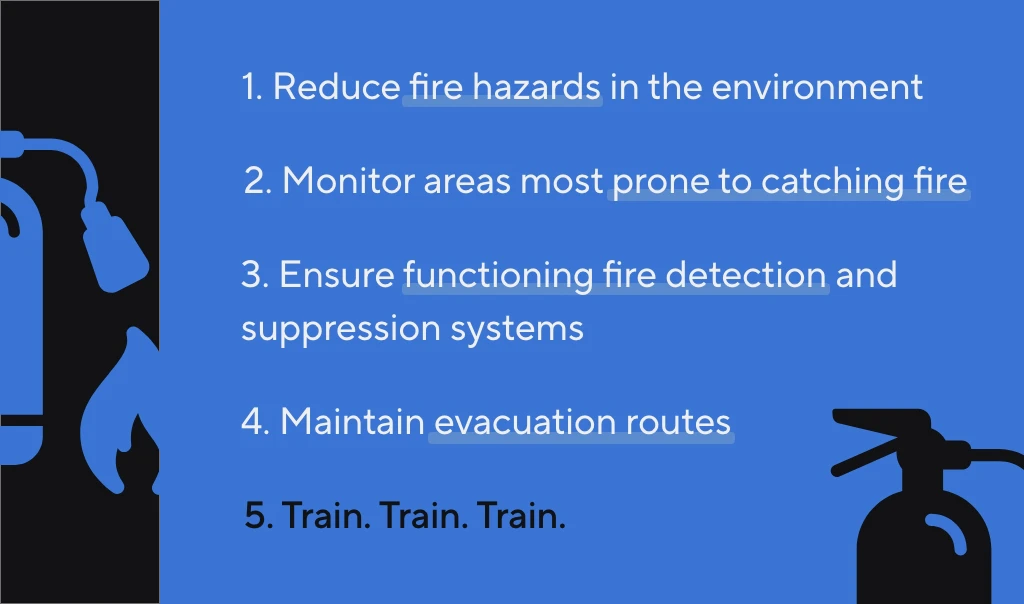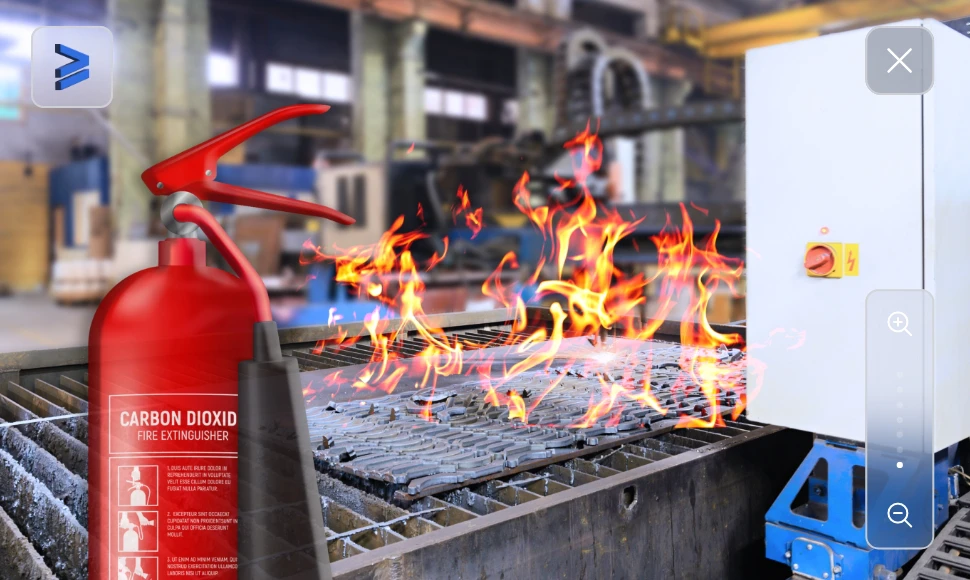The importance of fire safety training
Training staff in Occupational Health and Safety is – in most environments – required by law. The term relates to the prevention of accidents, reduction of hazards, and health risks related to performed work.
Educating employees on procedures and fire safety requirements contributes to the overall security of the workplace – the property and the people present in it. Properly trained personnel can successfully prevent fires from occurring and eradicate the danger once a threat occurs.
Main principles of fire safety

Traditional fire safety training pain points

As in the case of other specialized training, fire safety, when presented on whiteboards and in paper materials, doesn’t look too alluring. Most probably, every employee has at least once in their life witnessed this kind of event. A group of people sitting at school-like desks, spending a few hours with an instructor talking about theoretical concepts and presenting some instructional video materials presumably remembering the VHS era. With a few paper copies of the effective law and some tests to fill in later, personnel is good to go. Surely, some of the participants will get to remember the procedures and location of fire extinguishers at the premises, but the training, for most staff seems just a formality to check off. What we’re saying is that the traditional paper copies and whiteboard notes model is oftentimes not sufficient to teach people about aspects deciding on their safety.
What helps greatly in proper memorization of procedures is performing actions related to the training material in a life-like environment. In contrast to traditional approaches, augmented reality training has all it takes to engage participants, realistically present the issues, and improve the efficiency of fire safety training.
How can AR help create better fire safety training?
The use of digital scenarios allows repetitive exercising of actions that could be too dangerous or too costly to execute live, especially by rookies. And that’s what course participants usually are, no one expects them to be seasoned firefighters.
Should a facility’s layout change (e.g. new installations, changes in the floor plan, remodeling of the building) or any new elements be added to the fire safety procedure in force – staff can be immediately retrained. As soon as the safety officer/OHS trainer provides up-to-date fire safety procedure and uploads it to the platform, personnel can undergo the training. No waiting for instructors to arrive at the plant, no gathering shift groups in classrooms, no printing of the newest paper manuals. With AR instructions, the whole personnel can gain access to the platform, carrying standardized and relevant tutorials.
Using AR tutorials and wearable devices, trainees can follow predefined paths and recognize potential fire hazards. Once identified, the threats can be taken care of and neutralized. The AR training consists of more than looking at a picture and pointing an exposed wire near a water tap, or drawing evacuation plans on the whiteboard.
Simulations help develop proper habits and train the correct behavior patterns in case danger is recognized. The digital training can be executed according to set requirements, either in a linear or nonlinear manner.
How does it look?
Learners are equipped with AR wearable devices to access previously prepared digital instructions. The display shows occurring dangers in their workplace and requires staff to undertake action appropriately to the problem. Once the employee sees a fire breaking out, their subsequent actions should include calling for help, engaging the alarm, using a fire extinguisher, or any other steps required by local law and on-site regulations. Depending on the performance and actions compliant with procedures the training can be passed.

Following virtual footsteps around the facility can include beacons or QR codes, scanning of which will launch appropriate lessons in premade scenarios. With each lap through the premises enhanced with digital content (arrows pointing at extinguishers, smoke detectors, alarm buttons, other safety measures), understanding of the fire safety system grows.
Benefits of augmented reality in fire safety training
Immersive training
Augmented/mixed reality training is immersive and more engaging than the traditional classroom model. Practice in life-like conditions improves understanding and recognition of occurring hazards. AR allows training in different scenarios, showing users the consequences of improper conduct or negligence – if trainees won’t follow the proper course of action, the display will present an outbreak of fire. More convincing than a picture in a coursebook, yet still not endangering course participants.
Skill consistency
With AR training, managers can ensure every employee has undergone the same training in the same conditions. No differences or irregularities caused by employees taking various classes or using outdated tutorials.
Validity
Always up-to-date with the latest regulations, newest equipment, procedures, room layouts, and emergency exits in the facility. Once any of the above changes, training can be easily updated for employees to catch up on changes.
Convenience and savings
Easy reporting on progress and training performance, showing management which employees need to repeat or complete training. Automation of training reduces trainer workload and allows for savings on e.g. single-use paper materials and classrooms.

Is AR the future of fire safety training?
Augmented reality carries a great potential for employee training. Advantages? AR content doesn’t cut off users from the real world – it supplements it. Switching educational materials from the traditional paper or whiteboard notes to interactive content improves engagement. In consequence, it boosts memorization.
Improving fire safety training with augmented reality is within easy reach. The Nsflow platform allows for hassle-free creation of engaging, life-like experiences for trainees. The Digital Workflows module arms instructors with the tools to retain knowledge using multiple media formats. AR tutorials require no coding skills and their creation reminds of building blocks.
Looking forward to creating engaging, substantive training for your staff? Try out fire safety instructions with Nsflow. Sign up for a free 14-days demo (AR device included!) and see how effortlessly you can create training workflows.
























